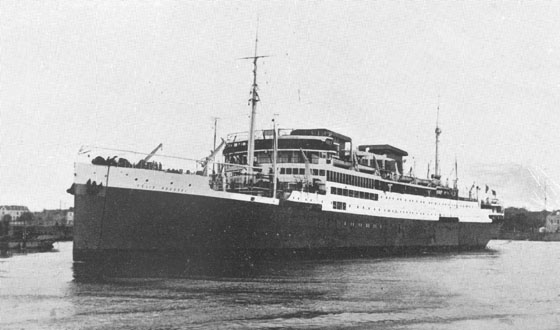
The Early Years & World War II
The Felix Roussel was built for the Messageries Maritimes (Compagnie des Messageries Maritimes) by Ateliers et Chantiers de la Loire, St Nazaire being launched on December 17th 1929. The ship was named after the former chairman of the company, M Felix Roussel, who passed away on September 6th 1925.
The hull was divided into nine watertight compartments, the bulkheads being fitted with four hydraulically operated Stone doors. Twenty four lifeboats were carried, including two motor lifeboats equipped with wireless. Deck equipment featured an electric windlass, four electric capstans, derricks included one 25 ton at the mizzen mast, one 10 ton at the main mast, six five ton and ten electric winches of three ton capacity. Brown Brothers provided the steering equipment and a gyroscopic compass. The passenger spaces symbolised a blending of European & Indo-China styling. The large dining room resembled the inside of an oriental Angkor temple with two large bronze seven-headed serpents mounted at the entrance. Oriental figures from Angkor graced the walls. Lighting accentuated the blue ceiling, suggesting a tropical sky. The smoking room was in the style of Toulouse architecture with a brickwork effect mixed with a variety of living palm trees. The cabins resembled rooms as found in a first-class hotel with some having private verandahs overlooking the ocean. Forced air provided adjustable ventilation for the passenger areas. The promenade deck contained large glass windows in order to deal with adverse weather conditions, the ceiling was painted green to minimize glare from the ocean. A swimming pool and tennis court provided recreation opportunities.
January 24th 1931: Marseilles - the new mail boat Jean Laborde was ceremonally inaugurated for the Far East run, following this the guests visted the Felix Roussel.
The Far East service beckoned for the Felix Roussel, her first sailing commenced on February 26th 1931 from Marseilles via the Suez Canal to Singapore, Saigon, Shanghai and Yokohama, with a timetabled arrival in Singapore on March 21st. In fact the ship arrived a day later after a sailing described as pleasant and uneventful, continuing on to Saigon, Hong Kong, Shanghai, Kobe & Yokohama. Regretably whilst at Singapore the baggage master M. Pelerin Balbini, a long time employee of Messageries Maritimes was severely injured whilst operating the ship's baggage lift between A & B deck. Attention from the ship's doctor was followed by surgery, regrettably Mr Balbini died shortly afterwards from his injuries whilst still at the Singapore General Hospital. A verdict of death by misadventure was recorded by the Singapore Coroner.
May 6th 1931: timetabled at Singapore for Marseilles.
November 1st 1931: at Singapore, from Marseilles for Saigon, Hong Kong, Shanghai & Kobe.
December 17th 1931: timetabled at Singapore from Saigon for Malacca, Colombo, Djibouti, Port Said & Marseilles.
February 20th 1932: at Singapore, from Marseilles for Saigon, Hong Kong, Shanghai, Kobe & Yokohama.
April 6th 1932: expected at Singapore (for six hours) from Saigon for Marseilles. Passengers on the ship included eight members of the Trans-Asian Expedition, which had recently lost its leader, M Haardt, who in an embalmed state would return to France on th ship. The expedition claimed to be the first party of Europeans to successfully travel from the Mediterranean via Syria, Iraq, Persia, Afghanistan, Pamir & Indo-China to Peking (Beijing) since the time of Marco Polo. Seven caterpillar cars (half tracks?), with trailers were used to make the trip. In crossing the Pamirs & Himalayas the vehicles had to be dismantled. A height of 13,775 feet was reached at one point, an altitude record at the time for a motor car (?).
June 12th 1932: at Singapore, from Marseilles for Saigon, Hong Kong, Shanghai, Nagasaki & Kobe.
July 27th 1932: timetabled at Singapore from Saigon for Malacca, Colombo, Djibouti, Port Said & Marseilles.
October 2nd 1932: timetabled at Singapore from France for Saigon, Hong Kong, Shanghai, Kobe & Yokohama.
November 16th 1932: timetabled at Singapore from Saigon for Malacca, Colombo, Djibouti, Port Said & Marseilles.
January 22nd 1933: at Singapore, from Marseilles for Saigon, Hong Kong, Shanghai, Nagasaki & Kobe.
February 22nd 1933: at Singapore from Saigon for Malacca, Colombo, Djibouti, Port Said & Marseilles.
May 14th 1933: at Singapore, from Marseilles for Saigon, Hong Kong, Shanghai & Kobe.
June 14th 1933: timetabled at Singapore from Saigon for Malacca, Colombo, Djibouti, Port Said & Marseilles.
August 20th 1933: timetabled at Singapore from France.
September 20th 1933: at Singapore.
November 22nd 1933: at Singapore, from Marseilles for Saigon, Hong Kong, Shanghai & Kobe. On arrival at Singapore trouble was being experienced with the port engine.
December 26th 1933: timetabled at Singapore from Saigon for Penang, Colombo, Djibouti, Port Said & Marseilles.
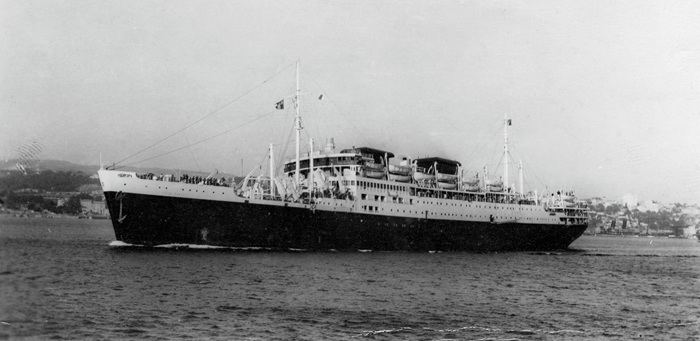

March 2nd 1934: at Singapore (for seven hours), from Marseilles for Saigon, Hong Kong, Shanghai, Nagasaki & Kobe.
April 3rd 1934: timetabled at Singapore from Saigon for Penang, Colombo, Djibouti, Port Said & Marseilles.
June 22nd 1934: at Singapore, from Marseilles for Saigon, Hong Kong, Shanghai, Nagasaki & Kobe.
July 24th 1934: timetabled at Singapore from Saigon for Malacca, Colombo, Djibouti, Port Said & Marseilles.
December 20th 1934: at Singapore, from Marseilles for Saigon, Hong Kong, Shanghai & Kobe.
January 22nd 1935: timetabled at Singapore from Saigon for Malacca, Colombo, Djibouti, Port Said & Marseilles.
March 28th 1935: at Singapore (7am - 2pm), from Marseilles for Saigon, Hong Kong, Shanghai & Kobe.
April 30th 1935: timetabled at Singapore from Saigon for Malacca, Colombo, Djibouti, Port Said & Marseilles.
During 1935 at Chantiers de la Coitat the ship underwent modifications including lengthening the ship by 26 feet, creating a sloping stem and increased horsepower from the engines, now with a top speed of 18.5 knots. Regular service recommenced on May 15th 1936 again on the Far East service.
June 16th 1936: at Singapore, from Marseilles for Saigon, Hong Kong, Shanghai & Kobe. It is reported that on this trip the Felix Roussel completed the Marseilles - Singapore passage in 17 days, a notable achievement.
On July 11th 1936 whilst on the River Yangtse the ship collided with the China Navigation Company vessel Yunan.
July 21st 1936: timetabled at Singapore from Saigon for Malacca, Colombo, Djibouti, Port Said & Marseilles. Passengers included the renowned French boxer Aime Raphael, headed for Colombo and his next fight.
October 23rd 1936: whilst departing Singapore a French sailor fell from the ship. His fall had been noticed, the ship circled, then came to a stop. Meanwhile a nearby sampan operator had also seen the fall of the sailor, the sampan rescued him and returned him to the Felix Roussel, making use of the Jacob's Ladder to reach to the deck.
November 24th 1936: timetabled at Singapore from Saigon for Malacca, Colombo, Djibouti, Port Said & Marseilles.
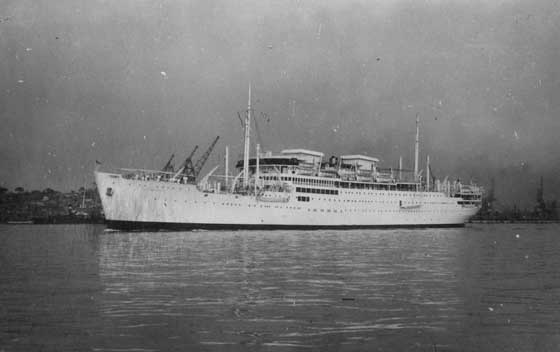
February 11th 1937: at Singapore, from Marseilles for Saigon, Hong Kong, Shanghai & Kobe.
March 16th 1937: timetabled at Singapore from Kobe for Malacca, Colombo, Djibouti, Port Said & Marseilles.
May 21st 1937: at Singapore, from Marseilles for Saigon, Hong Kong, Shanghai & Kobe.
June 22nd 1937: timetabled for eight hours at Singapore from Kobe for Malacca, Colombo, Djibouti, Port Said & Marseilles.
October 8th 1937: at Singapore, from Marseilles for Saigon, Hong Kong, Shanghai & Kobe.
November 12th 1937: at Singapore from Kobe for Malacca, Colombo, Djibouti, Port Said & Marseilles. Travelling on the ship was Tcheng Tchong Huim, the new Chinese Consul for Paris.
January 14th 1938: at Singapore, from Marseilles for Saigon, Hong Kong, Shanghai & Kobe.
May 19th 1938: at Singapore (8am to 5pm) from Japan for Marseilles.
August 12th 1938: at Singapore from Kobe for Malacca, Colombo, Djibouti, Port Said & Marseilles. Travelling on the ship was Tcheng Tchong Huim, the new Chinese Consul for Paris.
January 13th 1939: at Singapore, from Marseilles for Saigon, Hong Kong, Shanghai & Kobe. Travelling on the ship and headed for the United States was the 75 year old German-Jewish political economist Dr Franz Oppenheimer, accompanied by his daughter Renate. Dr Oppenheimer had help high positions in the universities at Berlin & Frankfurt.
February 14th 1939: timetabled at Singapore from Kobe for Malacca, Colombo, Djibouti, Port Said & Marseilles.
April 18th 1939: at Singapore, from Marseilles for Saigon only. The Felix Roussel was only travelling as far as Saigon in order to pick up passengers booked on the damaged Marechal Joffre (it had sustained collision damage with the P&O liner Canton). Passengers on the Felix Roussel destined beyond Saigon disembarked at Singapore and arranged forward travel by other vessels.
April 27th 1939: timetabled at Singapore from Saigon for Colombo, Djibouti, Port Said & Marseilles. Passengers included 250 French Colonial troops, mostly Annamites, headed for service in the French Mandate of Syria. Captain of the Felix Roussel was Jean Georges. The recent spate of fires on French liners, believed to be sabotage, saw the restriction of visitors to the French mail ships visiting Singapore, including the Felix Roussel. Only visitors known to the company agents or ticketed passenger were allowed on board.
June 28th 1939: at Singapore, from Marseilles for Saigon, Hong Kong, Shanghai & Kobe.
July 28th 1939: at Singapore for Marseilles.
At the beginning of World War Two the Felix Roussel was on a regular run from Marseilles to Shanghai via Suez, noted at Port Said on September 8th 1939, reaching Shanghai on October 6th 1939. Ten days were spent here before returing to Marseilles, arriving November 17th 1939. The next sailing left Marseilles on December 14th 1939, reaching Kobe, Japan on January 24th 1940, then returning to Marseilles by March 1st 1940. This was the last uninterrupted commercial sailing of the Felix Roussel, the war was about to catch up with her on the Far East service.
The last attempt at a round trip commenced on March 20th 1940 from Marseilles and calling in at Port Said (March 27th), Suez (March 29th), Colombo (April 8th - 12th), Saigon (April 23rd), Hong Kong (April 25th) and reaching Shanghai on April 27th 1940. On the return sailing from Shanghai the ship had reached Suez by June 3rd 1940, but was then detained by the British at Port Said (on or about June 6/13th?). The ship could not be legally detained in Egyptian waters, the intent being to sail the ship to Cypress or some other convenient British port in order to complete the requisition. The movement card for the period shows the following dates: Suez Canal September 3rd, Port Sudan September 6th & 7th and indicating a 'special route' to Aden. Aden was reached on September 12th and it was here that the ship was formally requisition by the British authorities. On September 13th the Felix Roussel sailed for Bombay arriving about October 5th. Operating under the Free French flag and managed by the Bibby Line the ship received some armament and was now manned by a mostly French volunteer crew. The earliest of these movements for the Felix Roussel involved the transport of troops from Australia & New Zealand to Egypt. Later regular movements were from Bombay to Suez and Malaysia to Suez.
In October 1940 the Felix Roussel was on a northbound troop movement to Port Said (Convoy BN7 Bombay - Suez?), being noted at Port Said from October 30th to November 1st, then to Suez, arriving November 11th. Conditions reported by the troops in transit paint a portrait of a ship and its crew badly in need of some refurbishment. Noted was the lack of ventilation on the troop deck, the troops preferring to sleep on the open decks but at the mercy of the heavy rains. Upon reaching Aden another twenty ships and their escort of armed merchantmen joined the convoy including the cruiser HMS Leander. Journeying north through the Red Sea Italian planes and later two Italian destroyers made daily attacks on the convoy without success. The convoy escorts were very successful in their actions against the Italians, though some damage was sustained to themselves. The Felix Roussel made a brief stop at Port Sudan for a few hours to replenish her water supply. Here a surprise attack by two Italian planes set bombs exploding either side of the ship, on the wharves and in the sea. The journey resumed with the ship steaming up the Suez Canal alone to Port Said.
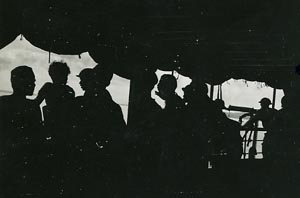 |
Deck conditions are illustrated in this silhouette view, possibly from December 1942, showing the awnings added to the decks to provide some shade from the tropical sun. Also visible, to the right, is one of the gun positions manned by a helmeted soldier. Photograph courtesy William Carruthers. |
As 1941 opened the Felix Roussel continued troop movements across the Indian Ocean, reaching Columbo by January 7th. The ship returned to Suez by February 6th, then headed east and reached Singapore by March 22nd. The ship returned to Bombay and was then stopped here for repairs which lasted until late August 1941. The next reported movement was from Bombay on September 19th 1941 headed to Aden, reaching Massawa by about October 10th. The last quarter of 1941 continued with trips across the Indian Ocean and Red Sea, though the orderliness of these movements would be altered by the events of December 7th 1941. Christmas 1941 was spent en-route between Aden & Suez whilst the New Year was at Suez.
On January 8th 1942 the Felix Roussel departed from Massawa for Aden (January 11th) and arriving Bombay January 17th 1942, setting the stage for its dramatic voyage to Singapore.
![]()
Convoy BM12 and Convoy EMU, the fall of Singapore
On January 23rd 1942 convoy BM12 departed Bombay for Singapore with 3,800 men from the 9th & 11th Northumberland Fusiliers and their associated supplies. The convoy consisted of the Empress of Asia, Felix Roussel, the Dutch vessel Plancius, the Devonshire and later joined by the City of Canterbury (recently involved in the mutiny at Durban). The Felix Roussel appears to have been primarily carrying stores and supplies. The convoy was protected by a strong naval presence, including HMS Exeter, the makeup of the escort changed as the voyage progressed.
Convoy BM12 combined at Addu Atoll with convoy DM2 (from Durban, originally bound for Singapore, but diverted to Batavia) on January 28th 1942 and proceeded to Batavia (Djakarta), arriving February 3rd 1942. Here the original members of BM12, joined by the City of Canterbury set out for Singapore.
Passing through the Banka Straits on February 4th at a speed of about twelve knots the ships came under attack from a formation of about 18 Japanese planes. All the bombs missed their mark but many of the ships were showered with water and bomb splinters. In return all the ships had opened fire on the planes though without success.
Following this attack two of the faster ships, the Plancius and Devonshire left the convoy in order to arrive at Singapore first thing the next morning. The remaining three ships including the Felix Roussel continued on at twelve knots, at this speed Singapore would be reached in about twenty hours. On the approach to Singapore on the morning of the 5th under fair skies the convoy came under attack from about twenty four twin-engined Japanese planes. All the ships were attacked with the largest ship, the Empress of Asia receiving an undue amount of attention. Direct hits to this ship led to major damage and fires eventually left no choice but to abandon her, throwing out the anchors about noon near Sultan Shoal Lighthouse, some eleven miles from Singapore. By a variety of means the troops and crew were evacuated from the Empress of Asia, one of the escorts, the HMAS Yarra taking off well over 1,000 troops and crew.
The Felix Roussel sustained several bomb hits, one penetrated the decks close by the bridge, another near a funnel hit a gun position killing a number of army gunners. The rudder was also damaged, however the fires were quickly extinguished and the vessel would reach the port of Singapore to discharge the troops and other cargo. This would be the last convoy to reach Singapore, more remarkable than most as the convoy arrived in daylight, with only token air cover and under an increasingly deteriorating situation as the Japanese escalated their assualt on the area. Japanese bombers had been able to reach Singapore since early December 1941 and had intensified their attacks during January 1942. Allied air cover had been strongly challenged by the Japanese, so much so that by February 8th 1942 the Japanese had control of the skies over Singapore.
Having disgorged her troops the Felix Roussel did not linger long at Singapore, along with the Devonshire & City of Canterbury they sailed for Bombay on the evening of February 8th 1942. The Felix Roussel carried at least 1,100 evacuated women and children, RAF personnel and some survivors from the Prince of Wales & Repulse, passing through the Sunda Strait on February 8th/9th under escort. Once clear of the strait the escort dropped away for other duties. The north shore of Singapore island was reached by Japanese troops on the evening of February 8th. Many ships would still continue to evacuate military personnel and civilians from Singapore until about February 13th, many of these small vessels were damaged or sunk by Japanese air attacks, with some of the survivors enduring or succumbing to horrific atrocities by the Japanese when captured. Singapore island surrendered on February 15th. On May 27th 1942 the Felix Roussel was named to the order of the Free French Forces May, ten crew members would receive the Croix de Guerre and Captain Snowling added a bar to his Distinguished Service Order. The ship itself would receive the Croix de Guerre honour on September 11th 1950.
At this time Captain Snowling and the senior 2nd Officer William Carruthers were the only British officers on the Felix Roussel, Mr Carruthers, along with several others received the Croix De Guerre, the citation reading:
Londres 27 May 1942
Le Generale de Gaulle
Commandant en chef des Forces Francaises Libres
cite a l'Order du jour des
Forces Francaises Libres
Le Paquebot 'Felix Roussel' pour l'admirable conduite de son Commandant, de son Etat-Major et de son Equipage lors de l'evacuation de Singapour. Lors d'une attaque par 27 avions japonais, deux de ceux-ci ont ete abattus et des incendies allumes par des bombes ont ete rapidement maitrises. A sauve et evacue au prix des plus grandes difficultes plus de mille femmes et enfants refugies sur les quais de Singapour.
Signe: De Gaulle
M. William Carruther, 2eme Officier faisait partie l'eqipage sous les ordres du Commandant Snowling lors du voyage de Singapore mentionne dans la citation ci-dessus.
The citation was signed by Capitaine Arnold, a second document indicated that Mr Carruthers had been assigned to the Felix Roussel from January 1st 1942 until his reassignment on April 1st 1943.
After arrival in Bombay about February 18th the Felix Roussel was stopped for nineteen days to make good the damage sustained during its round trip to Singapore. After disembarking her 2,400 evacuees the Devonshire also remained in Bombay for repairs taking thirteen days. At some point the Felix Roussel would visit Australia to allow for repairs to the Sulzer engines.
Following completion of the repairs the Felix Roussel left Bombay on March 20th 1942 with convoy BA 18 bound for Aden, then spending the remainder of March and April criss-crossing the Indian Ocean.
Shortly after noon on April 2nd the Felix Roussel departed Port Tewfik with a passenger cargo that included 75 soldiers under suspension (SUS), returning to Australia for completion of their sentences, being initially guarded by four officers and 27 ordinairy ratings under the command of Major Joseph 'Jerusalem Joe' Courtney, Commandant 1 of the 1st Australian Detention Barrack (1 ADB). Those in custody included convictions for murder, desertion, escaping custody, striking a superior officer, commission of a serious civil offense which included robbery with violence or assault occasioning actual bodily harm. The trip would not be an easy one, the staff quarters were far removed from the SUS quarters as were the toilet and washing facilities, all making for supervision difficult, especially at night. Another blow for Major Courtney was the security detail assigned to the SUS was allotted to other duties shortly after boarding the ship!
Aden was reached on April 6th where an additional SUS joined the Felix Roussel. The ship sailed from Aden on April 9th. Enroute sixty soldiers broke into the detention barrack and attempted to incite the SUS to join them in a riot. After the disturbance was dealt with twelve naval ratings were provided as a security detachment at the detention quarters. On April 15th Mombasa was reached, where Private Stuckey, SUS, left the ship by means of a port hole and was fished out of the harbour by the naval patrol. On the evening of April 20th an alcohol driven disturbance broke out in the detention quarters and quickly degenerated into a free-for-all fight. By 10pm the melee had been dealt with, the participants consigned to cells or the detention area. The source of the alcohol was reported as being passed to SUS in the toilet area by other soldiers. The Felix Roussel departed Mombasa on April 21st reaching Durban on April 27th where further trouble ensued. Private Meighan, SUS, apparently simply walked off the ship wearing a stolen sailor's uniform. The next morning eight others escaped through a port hole and onto the wharf. At noon the same day four SUS escaped by working loose boards covering the detention quarters and escaped down a nearby companionway. The next day the aformentioned Private Stuckey broke out of the ship's hold and escaped for a second time. On April 30th a further three SUS escaped. A number of the escapees were recaptured.
By now because of the damage sustained to the detention facilities, they were no longer considered secure enough to hold the SUS detainees. Ten SUS were transferred to the HMT Holbrook for transport to Australia, whilst the cells and ship's hold of the Felix Roussel became the new accommodation of the remaining SUS. The ship departed Durban on May 1st, reaching Fremantle on May 15th, Adelaide May 22nd and Sydney May 28th. Here 1 ADB disembarked, the SUS being transfered to shore based detention facilities. The ship was then stopped for much needed repairs from June 11th to August 12th. After the repairs were completed the Felix Roussel sailed from Sydney on August 24th 1942 headed for Fremantle and then Durban, arriving September 23rd 1942.
For the remainder of 1942 and into 1943 and through the middle of 1944 the Felix Roussel trooped between Suez - Bombay - Durban - Australia.
One highlight for comment was convoy WS22, Felix Roussel joined the convoy at Durban on October 3rd 1942, this convoy had sailed from the United Kingdom on August 29th 1942, in the convoy already were the Sulzer engined ships Johan Van Oldenbarnevelt, Rangitata & Sibajak. Also joining at Durban was the Sulzer engined Indrapoera! These five ships would not remain together long, the Felix Roussel arrived at Aden (for Suez) on October 16th 1942, the others split between Bombay & Mombasa.
Citation March 23rd 1943 - Cyclone damage
On February 14th 1943 the Felix Roussel departed Durban for Bombay, arriving here on March 3rd 1943, which set up the ship for another perilous journey. On March 18th 1943 the ship left Bombay on a voyage which would eventually take her into the Mediterranean theatre of operations. Unfortunately whilst crossing the Indian Ocean a very strong cyclone developed. The HMAS Nepal sailing from Durban on March 19th 1943 and headed for Fremantle, Australia suffered slight damage from this cyclone between Mauritius and Diego Garcia. The Felix Roussel may have endured the full brunt of the cyclone in light of the citation shown below. It was necessary to spend about a week in Mauritius to carry out emergency repairs.
Special Order Of The Day
by Major A R de H Mallock, OC Troops, HMT Felix Roussel
We have all been through a very unpleasant and trying experience - an experience none of us is likely to forget in a hurry. This ship has sustained a great deal of superficial damage, but as you can see for yourselves we are still on the move and the engines have never failed us once.
The work that all of you have done since the storm hit us is beyond all praise. Men, women and children have more than done their share to help to restore a semblance of normality to the ship. You have not all had the opportunity , as I have , of seeing the work done on the bridge, in the engine room, the hospital and so on, but I needn't tell you that we are in safe hands and need not worry if we should run into similar trouble again.
Finally, I fully realise that many of you have been injured, and many others have lost treasured possessions, but we are alive and let us thank God for it.
Good luck to you and a happy landing!
Signed AR de H Mallock, OC Troops 27/3/43
I also want to congratulate you all for the calm you showed in those tragic hours and to thank you heartily for the help you gave to my staff.
But, as your OC says 'Let's thank God'
Signed Jean Arnold, Captain. 'Felix Roussel' 27/3/43.
Departing Mauritius on April 5th 1943 the Felix Roussel reached Capetown on April 13th 1943, spending three weeks here before heading into the Atlantic to Takoradi (May 10th), Freetown (May 14th) and Gibraltar on May 23rd, 1943. By June 5th 1943 the ship was on the Clyde (Greenock June 6th), then it was down to Liverpool, reached on June 27th 1943. The next recorded sailing of the ship is when she is noted on trials out of Liverpool on April 11th 1944.
From the summer of 1944 into 1945 the ship shifted its sphere of operations to the Mediterranean theatre, frequently shuttling between the Clyde, Belfast, Liverpool and Port Said, Gibraltar & Algiers, with occasional trips to Freetown & Bombay. Christmas 1944 was spent at Belfast, the ship sailed for Liverpool on or about January 1st 1945, headed for Bombay and arriving there at the end of January. The ship was back on the Clyde by March 12th 1945. The next three months appear to have spent between the Clyde, Liverpool and Belfast. This changed on June 15th 1945 when the Felix Roussel left Gibraltar for Bombay, calling in at Algiers (Jun 16th), Malta (Jun 19th), Naples (Jun 20th), Taranto (Jun 23rd), Port Said (Jun 28th), Suez (Jun 29th) and Bombay (Jul 7th). After twelve days in Bombay the Felix Roussel made a round trip to Kilindini (Jul 26th) and Colombo (Aug 6th), returning to Bombay on August 11th 1945. With the war now over in the Pacific the ship set out from Bombay on August 25th 1945 for Cochin (Aug 27th) and Singapore, arriving on September 14th 1945 under conditions far more favourable than her last visit in February 1942. Departing Singapore on September 29th 1945 the Felix Roussel set sail on the long journey back to Liverpool including stops at Madras, Rangoon, Columbo, Suez (Oct 23rd/24th), Port Said (Oct 25th) arriving in Liverpool on November 5th 1945, no doubt with a shipload of war weary troops glad to be home.
![]()
Return to the peacetime Far East services
Although the war had been over for five months the movement of troops continued, some going home for demob, others heading in the opposite direction for a variety of assignments.
During mid-December 1945 the Felix Roussel was to sail for Kilindini and Durban, but engine repairs delayed the sailing until Christmas Eve. Apparently the engine repairs may not have been too successful, see notes below where a passenger indicates that after departing Liverpool the ship was reduced to operating with one engine. Gibraltar was reached on December 29th 1945, Taranto (Jan 1st 1946), Port Said, Suez (Jan 10th), Aden (Jan 20th), Kilindini and Durban (February 2nd 1946) where the ship required further repairs.
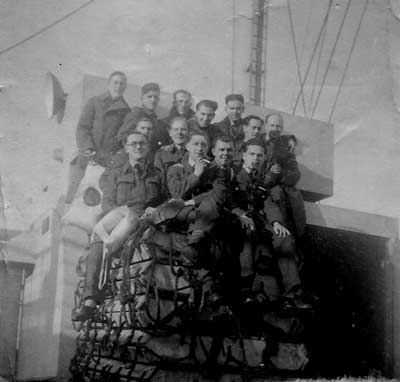
Since posting the above image some time ago, another person has been identified - Aubrey Shaw is in the back row, 4th from right and has memories of travelling on this ship to Port Said, Egypt Dec 1945 - Jan 1946.
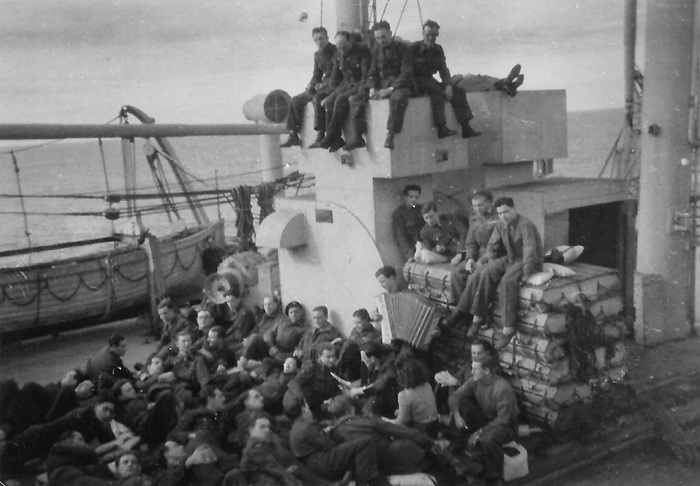
With regard to the above photograph Mr Shaw remembers that shortly after leaving Liverpool one of the main engines failed, causing the ship to lose time. The journey was rough, with a slow crossing of the Bay of Biscay and calling at Gibraltar. Possibly the ship next called at Tangiers or Algiers. A stop at Taranto, Italy followed in order to drop off some Italian 'prisoners'. Whether they were prisoners of war Mr Shaw doesn't remember, but there were three prisoners locked in cells in the bottom of the ship, it was very dark and dismal, Mr Shaw was on a guard duty rota for them! The ship headed for Egypt which is where Mr Shaw left the ship at Port Said.
Further observations below come from a traveller after the ship had received repairs in early February 1946. Regrettably I've misplaced the name of the traveller.
16.2.46
Tomorrow we embark.
HMT Felix Roussel carrying Greek refugees & 1,000 Italian collaborators, it should be one hell of a journey. Said cheerio to H and family and Lt Cummings last night. It has been a pleasant break in Durban.
18.2.46
Sailed from Durban 06.35. Took on 1,000 Italians last night, about 500 already on board. I am 1/c of one-deck. Hope my knowledge and language holds out OK. Some civvies going to Egypt, Palestine and Mombasa. A very grand dining saloon but putrid ablutions. Food not so good. Twelve officers in one dormitory. Duchess of Bedford entered Durban Harbour as we left. Sharks are menace to Durban bathers.
23.2.46
Berthed at Mombasa 17.00hrs. Went ashore with the ladies. Had dinner at Officers’ Club.
24.2.46
Went ashore with Mrs Johnson & child, bought fruit and saw town and market. Tea at club. Sailed at 17.30 after taking on passengers.
25.2.46
Kippers for breakfast.
26.2.46
Crossed the line at 04.00hrs. Ceremony at 17.00hrs. I am Royal Gate Keeper. One little boy defended the queen. 'Have a Heart'.
5.3.46
Arrived Port Tewfik 12.00hrs. Italians from East Africa disembarked.
6.3.46
Disembarked 13.00hrs via Ismalit Qassian. Entrained 16.15, arrived PCD 19.00hrs. Cold.
As detailed above the Felix Roussel departed Durban on February 16th, Kilindini (Feb 18th), Suez, arriving March 5th and departing March 9th for Mombasa, arriving March 18th. Durban was reached om March 25th where further repairs were made. At this point the ship was released back to its French owners with the Form T509 signed at Port Natal on April 15th 1946.
On April 15th 1946 the Felix Roussel was officially handed back to Messageries Maritimes whilst at Durban. This allowed it to sail on its pre-war route returning many displaced persons from Europe back to Indochina, the ship noted making sailings in Nov/Dec 1946, Aug/Sept 1947 & Mar/April 1948.
December 18th 1946: timetabled at Singapore from Marseilles.
March 15th 1947: at Singapore for Saigon, Hong Kong & Shanghai with troops and about 30 passengers embarking at Singapore.
April 18th 1947: at Singpore, embarking were 400 Ceylonese deck passengers for Colombo.
On June 25th 1948 the ship sailed to Chantiers de Dunkirk for a refit to restore her for commercial service. The refit was completed by September 1950, changes included the two square funnels being reduced to one oval one. She resumed service on the Marseilles - Saigon - Hong Kong - Japan service on 22nd September 1950. This service was worked for the next five years, the last sailing to the Far East commenced on February 22nd 1955 (returning April 25th 1955?).
October 12th 1950: Singapore - a cocktail party for 160 guests took place on the Felix Roussel in celebration of the ship's return to the Far Eastern service after a break of ten years. With more than 860 passengers & troops on board the service was headed for Saigon, Hong Kong & Manila, with future plans to call at ports in Japan.
November 1st 1950: at Singapore from Saigon for Marseilles.
March 27th 1951: the Felix Roussel and the freighter Valery en Caux passed through Singapore en-route to Indo-China with 1,000 troops. The ships stopped at Pulau Bukom for oil.
June 16th 1951: at Singapore.
September 7th 1951: at Singapore.
December 18th 1951: Singapore - after arrival only one passenger out of 1,000 onboard disembarked. The passengers included 400 most Senegalese troops returning to France after two & a half years service in Indo-China.
March 15th 1952: at Singapore for Marseilles, her passengers included 200 French & Colonial troops returning from Indo-China after two and a half years service in the east.
May 15th 1952: at Singapore from Marseilles to Saigon, passengers included female members of the French Navy headed for deployment in Indo-China.
January 21st 1953: Singapore, noted on board on a round-the-world trip was British car manufacturer magnate Sir Reginald Routes and his wife. Also whilst en-route from Colombo Mrs A I Khan, wife of the new office superintendent at the Pakistani Trade Commissioner's office in Singapore gave birth to a son.
September 28th 1953: departed Singapore with 131 passengers for Saigon and 302 French troops headed for Indo-China.
October 10th 1953: at Singapore.
February 24th 1954: at Singapore.
May 17th 1954: timetabled from Singapore to Marseilles.
September 23rd 1954: timetabled from Singapore to Saigon.
October 6th 1954: departed Singapore for Marseille with 508 French troops in transit from Indo-China for redeployment in Oran. 318 other passengers were travelling on the ship.
December 9th 1954: at Singapore from Marseilles, for Saigon.
December 20th 1954: timetabled at Saigon for Marseilles.
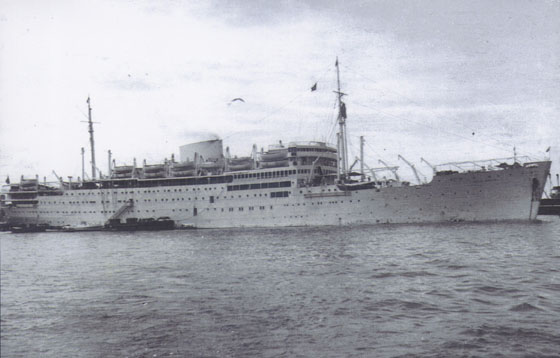
New ownership and a new name.
Last sechduled westbound sailing March 1955.
March 16th 1955: scheduled departure from Singapore to Saigon.
March 27th 1955: scheduled departure from Singapore to Marseilles.
After the last Far East service had been completed the ship was retired from service on April 24th 1955 and sold for $3.5 million to the Arosa Line of Panama and renamed the Arosa Sun. A refit took place at Trieste for Atlantic service. Changes included an increase in weight to 20,126 gross tons, the promenade deck was glassed in, the number of lifeboats reduced and her passenger capacity changed to 60 1st Class and 890 Tourist Class.
On July 14th 1955 her first voyage commenced from Trieste to Palermo, Naples, Lisbon, New York, Quebec, Havre, Southampton and Bremen. On August 20th 1955 her regular route commenced from Bremen - Southampton - Havre - Quebec.
Sailings from July-December 1956 for the Arosa Sun included Hamburg, Southampton, Le Havre, Quebec with a crossing time of ten days. One westbound voyage substituted Montreal instead of Quebec. Eastbound voyages from Quebec (one from Montreal) called at Cuxhaven with debarkation for Hamburg; one voyage from Quebec to Bremerhaven instead of Cuxhaven. These services were used by many Hungarian refugees heading for Canada after the revolution in Hungary during 1956. When the first ship, the Arosa Sun, arrived in Quebec on December 10th 1956 carrying 257 Hungarian immigrants, it was greeted by a cheering flag-waving crowd of 3,000 people. Nearly 40,000 Hungarians responded to Canada's open door policy.
In 1957 the Arosa Line acquired the La Marseilles which would be renamed the Arosa Sky, this vessel was also powered by Sulzer engines.
On March 15th 1958 the Arosa Sun sustained an engine explosion off the Columbian coast with the loss of two lives. The ship was towed to Cristobal then on to Baltimore for repairs, resuming service on May 12th 1958 with a sailing from New York to Bremen.
Her last voyage commenced September 13th 1958 to Bremen - Quebec - Montreal - Quebec - Plymouth - Havre - Bremen. In December of that year the ship was seized at Bremen due to the Arosa Line's outstanding debts. Bankruptcy followed and the ship was auctioned off in 1960 to Koninglijke Nederlandsche Hoogoven & Stalfabrieken, with the ship converted at Ijmuiden to become a floating hostel for steel workers at Ymuiden, Holland. The ship sustained fire damage during April 1963. The floating hostel function ended on March 3rd 1974 when the Arosa Sun was towed away to Bilbao for scrapping. On March 28th 1974 she arrived at Bilbao to be broken up by Hierros Ardes.
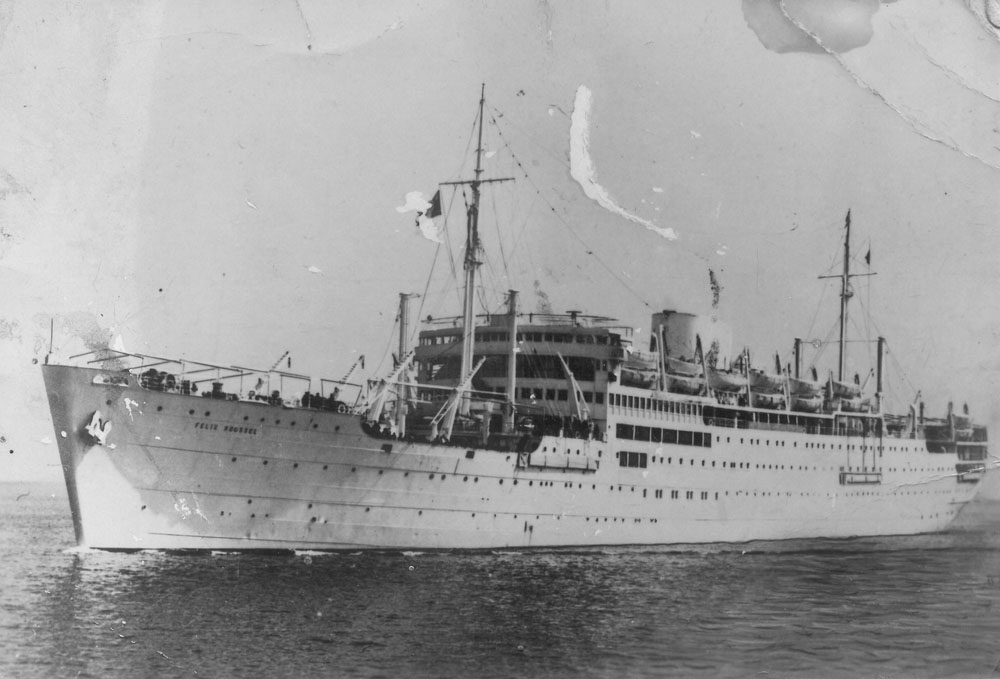
Builder: Ateliers et Chantiers de la Loire, Saint-Nazaire
Launched: December 17th 1929
Gross Weight: 16,774 tons, 17,084 after 1935.
Deadweight: 21,000 tons
Length: 533 feet, 171.25 metres
Beam: 68 feet, 20.8 metres
Draught: 28 feet
Engines: Two CCM Sulzer 2-stroke single acting 10 cylinder 10ST68 engines totalling 14,700hp at 110rpm, 16,000hp after 1935
Auxiliary engines: Two x 6DH38 and three x 5DH38 totalling 2,500hp at 250rpm.
Screws: 2
Service Speed: 15 knots
Passenger Capacity: 196 first, 110 second, 3rd 90 (after 1935).
Troop Capacity: 1,183 to 1,502
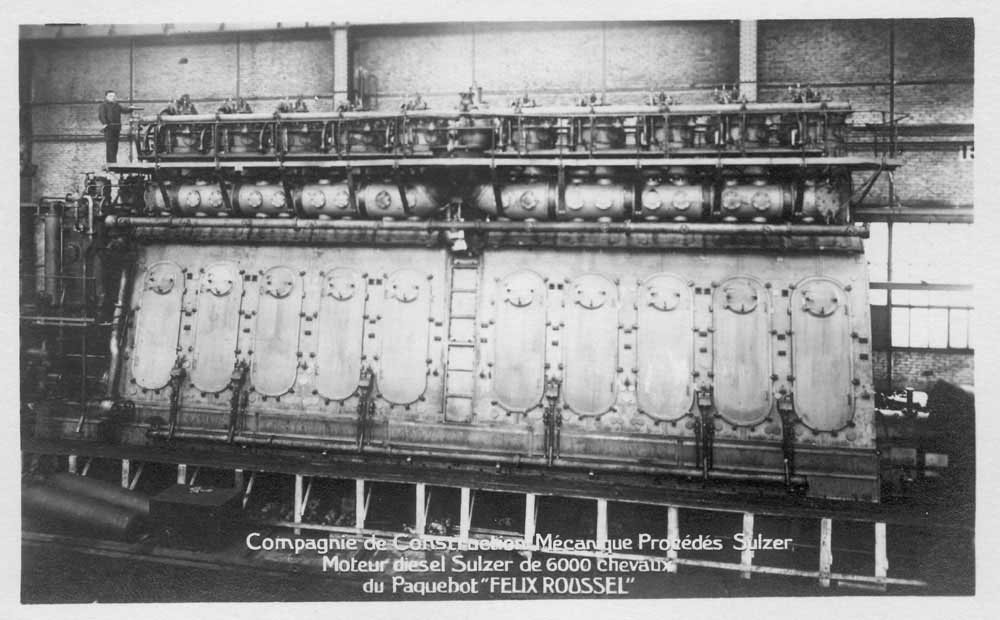
![]()
As mentioned above in the text the 2nd officer on the Felix Roussel for fifteen months was Mr William Carruthers, a lifelong seaman, whose time on the ship occurred during several of its most dangerous voyages.
William had left school at age fourteen, went to sea on a trawler to Iceland by age fifteen and became an Able Seaman by seventeen. With the start of World War Two came further adventures including time as Chief on the Egyptian vessel Tiaf and the Bantria (Cunard). Then came the Felix Roussel acting as the Liaison Officer for the troops. After leaving the Felix Roussel in 1943 William obtained his Master Mariner's ticket at age 29, and joined the Queen Elizabeth as Senior Second Officer, and later as First Officer on the Ile de France and the Ascania. He came ashore in 1947 and taught at the Navigation School at Fleetwood, Lancashire and later became Principal and built the Fleetwood Nautical College.
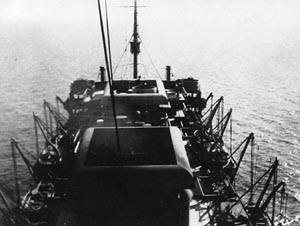 |
William was not afraid of heights, so the taking of this picture from the main mast looking aft was not a problem. Although fitted with two funnels only the nearer one actually served its intended purpose. The aft funnel was a dummy but after her sister ship the Georges Phillipar caught fire in the Red Sea and burnt out before the war, the funnel was filled with fire fighting equipment and sprinklers were installed between decks. No doubt these refinements prevented the ship from sustaining more fire damage whilst under attack en route to Singapore. The extra life boats were self launching and added when the ship became a troop carrier. Photograph courtesy William Carruthers. |
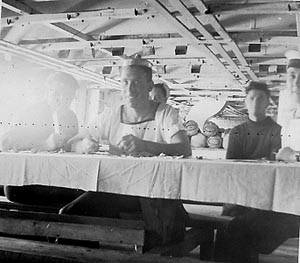 |
For six years the Felix Roussel ferried troops to a variety of locations. In this view a troop movement is taking place between Durban & Suez. Its meal time and its Christmas Day (1942?), hence the presence of the white tablecloths in celebration. The Christmas meal of sorts was of course cooked by a French chef! Photograph courtesy William Carruthers. |
 |
After its fateful trip to and from Singapore during February 1942 the Felix Roussel required repairs to put right the damage sustained in the Japanese air attacks. After reaching Bombay the ship was placed in dry dock, where she is seen in this view. It took only nineteen days to make right the damage sustained. About a year later whilst in the Indian Ocean the Felix Roussel would cross the path of a severe cyclone which caused minor damage to the ship and injuries to many on board. The dining room windows broke with some flooding, tables were used as makeshift barriers to stop the ingress of water, sailing like that to reach port where repairs were made. |
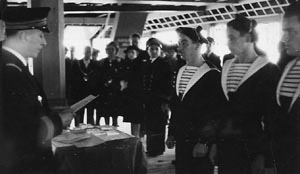 |
When the Felix Roussel returned to Liverpool, the opportunity occurred for a presentation of the Croix de Guerre medals to those crew honoured for their service during the February 1942 trip to Singapore. The ceremony took place on the bridge of the Felix Roussel. To the left is the leader of the Free French in Liverpool, William Carruthers is behind the Mayor and his wife, with his cap on. In the center is Captain Jean Arnold, who replaced Captain Snowling, the captain of the Felix Roussel at the time of the Singapore trip. Free French Merchant Navy photograph. |
Sources
Singapore Newspapers/National Library Singapore Archive (next #48).
Information related to William Carruthers graciously provided by Judith Curwen.
AWM52 18/3/8 War Diary, 1 Aust Detention Barrack Middle East (information as provided by Graham Wilson, Canberra, Australia: to be incorporated in the book 'Accommodating the King's Hard Bargain: A History of Military Detention in the Australian Army 1914-1947).
Aubrey Shaw (via Geoff Shaw) photograph and memories Dec 1945 - February 1946.
Page added June 6th 2007
Last updated October 30th 2025
Return to Ship menu
Return to site menu